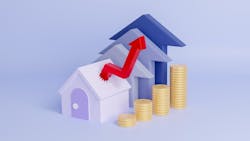Monthly Mortgage Payments Soar to New Record High
The average 30-year mortgage rate hit 6.7% for zero points and top tier scenarios on Friday, the highest rate in 20 years, according to Bill McBride in the CalculatedRisk Newsletter. Principal and Interest payments (P&I) are up 59% year-over-year for a fixed amount, well above the previous record increase of 50% in 1980, and the most recent P&I measurement doesn’t take into account rising house prices.
As interest rates continue to rise, home sales are slowing across the U.S., but builders can expect a rebound in buyer demand as a slowdown pushes the housing market back to an equilibrium after a two-year push and pull between buyers and sellers.
In the 1980 period, new home sales fell about 40% YoY and about 60% from the peak in the 1970s to the trough in 1980. A similar decline might push new home sales down to around 400 thousand SAAR in coming months.
Even though we can expect significant further declines in new home sales and single-family housing starts, the good news for the homebuilders is activity usually picks up quickly following an interest rate induced slowdown (as opposed to following the housing bust when the recovery took many years).
